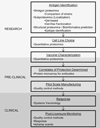Proteomic contributions to our understanding of vaccine and immune responses
- PMID: 26172619
- PMCID: PMC4713355
- DOI: 10.1002/prca.201500054
Proteomic contributions to our understanding of vaccine and immune responses
Abstract
Vaccines are one of the greatest public health successes; yet, due to the empirical nature of vaccine design, we have an incomplete understanding of how the genes and proteins induced by vaccines contribute to the development of both protective innate and adaptive immune responses. While the advent of genomics has enabled new vaccine development and facilitated understanding of the immune response, proteomics identifies potentially new vaccine antigens with increasing speed and sensitivity. In addition, as proteomics is complementary to transcriptomic approaches, a combination of both approaches provides a more comprehensive view of the immune response after vaccination via systems vaccinology. This review details the advances that proteomic strategies have made in vaccine development and reviews how proteomics contributes to the development of a more complete understanding of human vaccines and immune responses.
Keywords: Systems biology; Vaccine; Vaccinology.
© 2015 WILEY-VCH Verlag GmbH & Co. KGaA, Weinheim.
Conflict of interest statement
The authors have declared no conflict of interest.
Figures




Similar articles
-
Systems integration of innate and adaptive immunity.Vaccine. 2015 Sep 29;33(40):5241-8. doi: 10.1016/j.vaccine.2015.05.098. Epub 2015 Jun 21. Vaccine. 2015. PMID: 26102534 Review.
-
Proteomics approaches towards antigen discovery and vaccine development.Curr Opin Mol Ther. 2002 Jun;4(3):216-23. Curr Opin Mol Ther. 2002. PMID: 12139306 Review.
-
Novel vaccine design based on genomics data analysis: A review.Scand J Immunol. 2021 Mar;93(3):e12986. doi: 10.1111/sji.12986. Epub 2020 Oct 26. Scand J Immunol. 2021. PMID: 33043473 Review.
-
Systems vaccinology.Immunity. 2010 Oct 29;33(4):516-29. doi: 10.1016/j.immuni.2010.10.006. Immunity. 2010. PMID: 21029962 Free PMC article. Review.
-
The omics strategy: the use of systems vaccinology to characterize immune responses to childhood immunization.Expert Rev Vaccines. 2022 Sep;21(9):1205-1214. doi: 10.1080/14760584.2022.2093193. Epub 2022 Jul 5. Expert Rev Vaccines. 2022. PMID: 35786291 Review.
Cited by
-
Discovery of Schistosoma mekongi circulating proteins and antigens in infected mouse sera.PLoS One. 2022 Oct 13;17(10):e0275992. doi: 10.1371/journal.pone.0275992. eCollection 2022. PLoS One. 2022. PMID: 36227939 Free PMC article.
-
Multi-epitope vaccine candidates based on mycobacterial membrane protein large (MmpL) proteins against Mycobacterium ulcerans.Open Biol. 2023 Nov;13(11):230330. doi: 10.1098/rsob.230330. Epub 2023 Nov 8. Open Biol. 2023. PMID: 37935359 Free PMC article.
-
Multi-omics-based characterization of the influences of Mycobacterium tuberculosis virulence factors EsxB and PPE68 on host cells.Arch Microbiol. 2023 May 10;205(6):230. doi: 10.1007/s00203-023-03576-y. Arch Microbiol. 2023. PMID: 37162591 Free PMC article.
-
Cellular and Molecular Immunity to Influenza Viruses and Vaccines.Vaccines (Basel). 2024 Apr 7;12(4):389. doi: 10.3390/vaccines12040389. Vaccines (Basel). 2024. PMID: 38675771 Free PMC article. Review.
-
Systems vaccinology and big data in the vaccine development chain.Immunology. 2019 Jan;156(1):33-46. doi: 10.1111/imm.13012. Epub 2018 Nov 13. Immunology. 2019. PMID: 30317555 Free PMC article. Review.
References
-
- World Health Organization. The Global Burden of Disease 2004 Update. Geneva: Switzerland; 2008.
-
- National Institute of Allergy and Infectious Diseases. NIAID: Planning for the 21st Century. 2000
-
- Germain RN. Vaccines and the Future of Human Immunology. Immunity. 2010;33:441–450. - PubMed
-
- World Health Organization. Global Vaccine Action Plan 2011–2020. Geneva: Switzerland; 2013.
-
- World Health Organization. Antigenic and genetic characteristics of zoonotic influenza viruses and development of candidate vaccine viruses for pandemic preparedness. 2013 - PubMed
Publication types
MeSH terms
Substances
Grants and funding
LinkOut - more resources
Full Text Sources
Other Literature Sources
Medical

